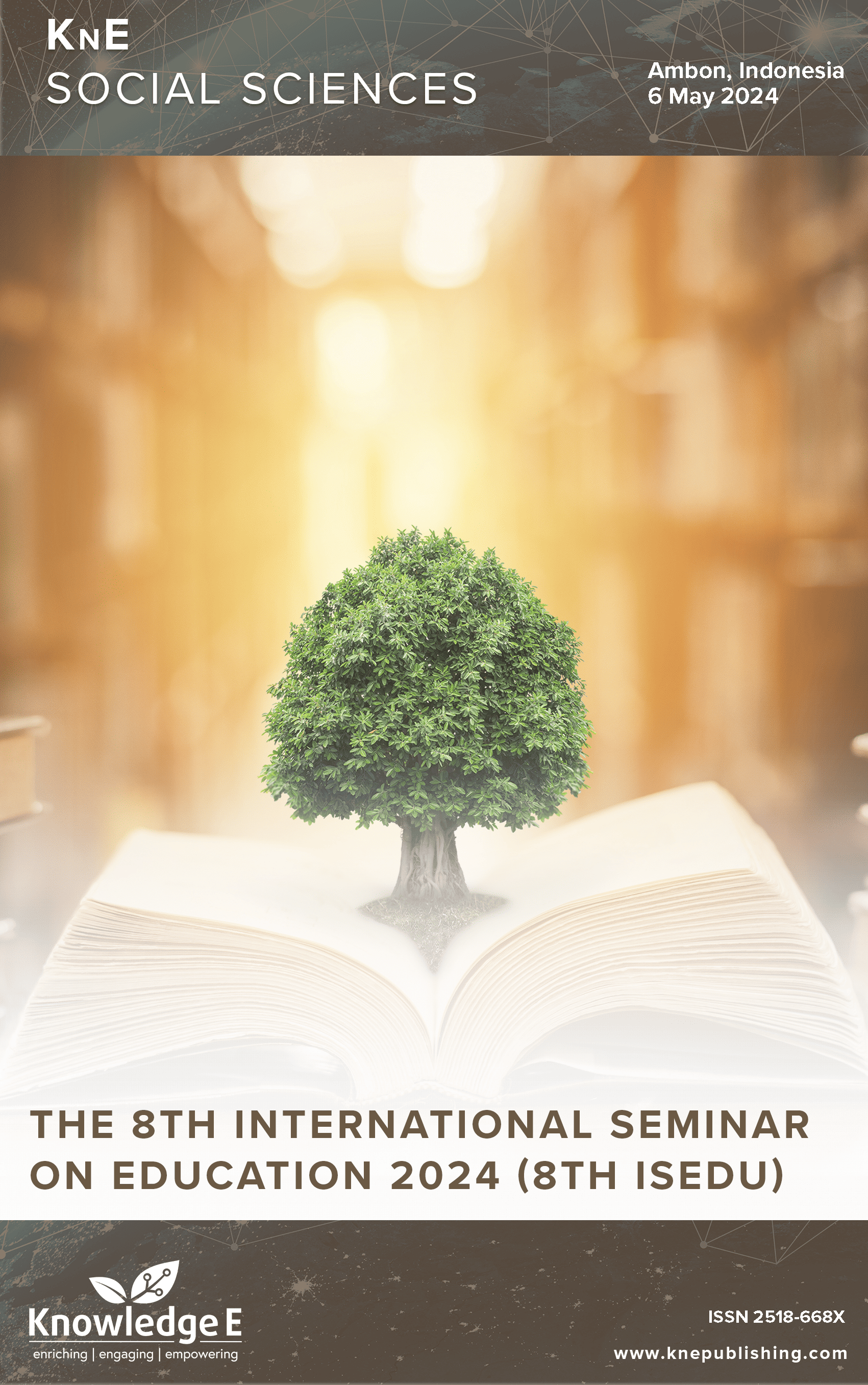Facilitating Students' Cognitive Engagement in Online Asynchronous Discussion Within a Remote English Foreign Language Learning Environment
DOI:
https://doi.org/10.18502/kss.v9i31.17586Abstract
This study examined the cognitive presence of students in an asynchronous online discussion in the Second Language Acquisition (SLA) course. The course combined synchronous meetings through Zoom sessions to support student participation in asynchronous discussions. The study involved a cohort of 36 participants from the two remote extended campuses of Pattimura University in Maluku. Through content analysis, two key aspects were examined: (1) student participation rates, and (2) the extent of students’ cognitive presence within the discussions. The content analysis findings revealed that although each student made a minimum of two contributions per topic during online asynchronous discussions, they exhibited a moderately high level of cognition, incorporating problem recognition, exploration, integration, and solution, not only in individual messages but also in the overall exchange of information within the discussion thread. These findings suggest that a combination of synchronous meetings through Zoom sessions, tailored prompts, feedback, and social interactions enhances students' active engagement and utilization of cognitive skills in online asynchronous discussions.
Keywords: online asynchronous discussion, English foreign language learning, cognitive presence
References
Bates JB, Sangra A. Managing technology in higher education: Strategies for transforming teaching and learning. John Wiley & Sons; 2011.
Siemens G, Long P. Penetrating the fog: Analytics in learning and education. EDUCAUSE Rev. 2011;46(5):30–40.
Tomlinson CA. How to differentiate instruction in mixed-ability classroom. 2nd ed. Alexandria (VA): ASCD; 2001.
Chi MT, Wylie R. The ICAP Framework: Linking cognitive engagement to active learning outcomes. Educ Psychol. 2014 Oct;49(4):219–43. DOI: https://doi.org/10.1080/00461520.2014.965823
Means B, Toyama Y, Murphy R, Bakia M, Jones K. Evaluation of evidence-based practice in online learning: A meta-analysis and review of online learning studies. US Department of Education; 2010.
Giacumo LA, Savenye W. Asynchronous discussion forum design to support cognition: effects of rubrics and instructor prompts on learner’s critical thinking, achievement, and satisfaction. Educ Technol Res Dev. 2020 Feb;68(1):37–66. DOI: https://doi.org/10.1007/s11423-019-09664-5
Elaine Allen I, Seaman J, Garrett R. Blending In: The extent and promise of blended education in the United States [Internet]. Sloan Consortium.PO Box 1238, Newburyport,MA 01950; 2007 [cited 2023 Aug 21]. Available from: https://files.eric.ed.gov/fulltext/ED529930.pdf
Yamagata-Lynch LC. Blending online asynchronous and synchronous learning. Int Rev Res Open Distance Learn. 2014;15(2):189–212. DOI: https://doi.org/10.19173/irrodl.v15i2.1778
Lock J. New image: Online communities to facilitate teacher professional development. J Technol Teach Educ. 2006;14(4):663–78.
Dziuban CD, Hartman JL, Moskal PD. Blended learning [Internet]. 2004. Available from: www.educause.edu/ecar/
Taplin RH, Kerr R, Brown AM. Who pays for blended learning? A cost-benefit analysis. Internet High Educ. 2013 Jul;18:61–8. DOI: https://doi.org/10.1016/j.iheduc.2012.09.002
Thomson DL. Beyond the classroom walls: Teachers’ and students’ perspectives on how online learning can meet the needs of gifted students. J Adv Academics. 2010;21(4):662–712. DOI: https://doi.org/10.1177/1932202X1002100405
Bonk CJ, Graham CR. The handbook of blended learning: Global perspectives, local design. Pfeiffer, A Wiley Imprint; 2006.
Shea P, Sau Li C, Pickett A. A study of teaching presence and student sense of learning community in fully online and web-enhanced college courses. Internet High Educ. 2006 Sep;9(3):175–90. DOI: https://doi.org/10.1016/j.iheduc.2006.06.005
Garrison DR. Online community of inquiry review: Social, cognitive, and teaching presence issues. J Asynchronous Learn Netw. 2007;11(1):61–72. DOI: https://doi.org/10.24059/olj.v11i1.1737
Ke F. Examining online teaching, cognitive, and social presence for adult students. Comput Educ. 2010 Sep;55(2):808–20. DOI: https://doi.org/10.1016/j.compedu.2010.03.013
Garrison DR, Cleveland-Innes M. Facilitating cognitive presence in online learning: Interaction is not enough. Int J Phytoremediation. 2005;21(1):133–48. DOI: https://doi.org/10.1207/s15389286ajde1903_2
Shea P, Hayes S, Vickers J, Gozza-Cohen M. Sedef Uzuner RM, Anna Valchova PR. A re-examination of the community of inquiry framework: Social network and content analysis. Elsevier. 2010;13. DOI: https://doi.org/10.1016/j.iheduc.2009.11.002
Garrison DR, Arbaugh JB. Researching the Community of Inquiry Framework: Review, Issues, and Future Directions. Thousand Oaks, CA: Sage Publication; 2007. 1–25 p.
Garrison DR, Arbaugh JB. Researching the community of inquiry framework: Review, issues, and future directions. Internet High Educ. 2007;10(3):157–72. DOI: https://doi.org/10.1016/j.iheduc.2007.04.001
Arbaugh JB, Hwang A. Does “teaching presence” exist in online MBA courses? Internet High Educ. 2006 Mar;9(1):9–21. DOI: https://doi.org/10.1016/j.iheduc.2005.12.001
Ally M. Foundations of educational theory for online learning [Internet]. 2008. Available from: http://www.aupress.ca/books/120146/ebook/01_Anderson_2008-
Kuo YC, Walker AE, Schroder KE, Belland BR. Interaction, Internet self-efficacy, and self-regulated learning as predictors of student satisfaction in online education courses. Internet High Educ. 2014;20:35–50. DOI: https://doi.org/10.1016/j.iheduc.2013.10.001
Griffin I. Adult learner engagement with learning support in a blended learning environment in Irish insurance education. Dissertation submitted to Dublin Institute of Technology in partial fulfillment of Masters (MA) in Higher Education [Internet,Dissertations]. 2015. Available from: https://arrow.dit.ie/cgi/viewcontent.cgi?article=1029&context=ltcdis
Hara N, Kling R. Students’ frustrations with a web-based distance education course. First Monday. 1999;4(12):68–9. DOI: https://doi.org/10.5210/fm.v4i12.710
Bolliger DU, Martindale T. Key factors for determining student satisfaction in [Internet]. Int J Learn. 2004;6(2):61–7. Available from: http://portal.acm.org/citation.cfm?id=1371264.1371454
Bolliger DU, Martindale T. Key factors for determining student satisfaction in [Internet]. Int J Learn. 2004;6(2):61–7. Available from: http://portal.acm.org/citation.cfm?id=1371264.1371454
Martin F, Bolliger DU. Developing an online learner satisfaction framework in higher education through a systematic review of research. Volume 19. International Journal of Educational Technology in Higher Education. Springer Science and Business Media Deutschland GmbH; 2022. DOI: https://doi.org/10.1186/s41239-022-00355-5
Angelino LM, Keels Williams F, Natvig D. Strategies to engage online students and reduce attrition rates. Vol. 4. J Educ Online. 2007;4(2). https://doi.org/10.9743/JEO.2007.2.1 DOI: https://doi.org/10.9743/JEO.2007.2.1
Creswell JW. Qualitative inquiry and research design: choosing among five traditions [Internet]. Qual Health Res. 1998;9:403. Available from: http://en.wikipedia.org/wiki/Emic_and_etic31. Yin RK. Case study research: design and methods. Vol. 5. Sage. 2009.
Angelova M, Zhao Y. Using an online collaborative project between American and Chinese students to develop ESL teaching skills, cross-cultural awareness and language skills. Comput Assist Lang Learn. 2016;29(1):167–85. DOI: https://doi.org/10.1080/09588221.2014.907320
Hara Noriko, Bonk Jay Curtis, Angeli Charoula. Content analysis of online discussion in an applied educational psychology course. 2000.
Arbaugh JB, Bangert A, Cleveland-Innes M. Subject matter effects and the Community of Inquiry (CoI) framework: An exploratory study. Internet High Educ. 2010 Jan;13(1–2):37–44. DOI: https://doi.org/10.1016/j.iheduc.2009.10.006
Garrison D. Randy; Anderson, Terry; Archer W. Critical inquiry in a text-based environment: In computer conferencing in higher education. Internet High Educ. 2000;2(2–3):87–105. DOI: https://doi.org/10.1016/S1096-7516(00)00016-6

